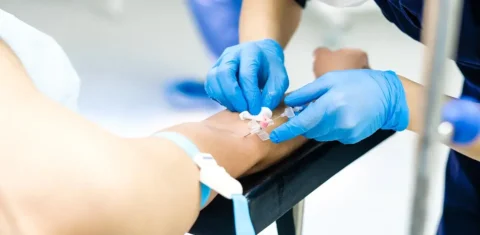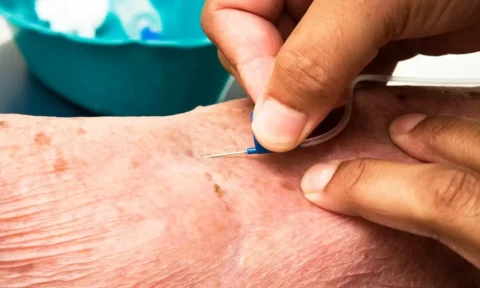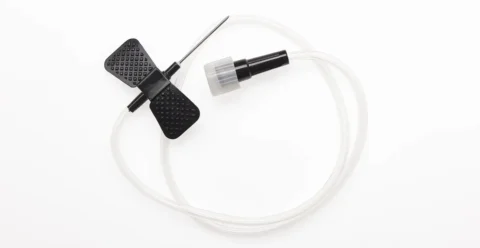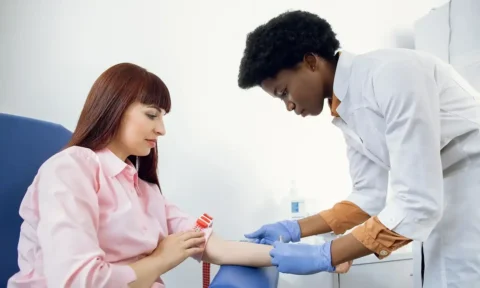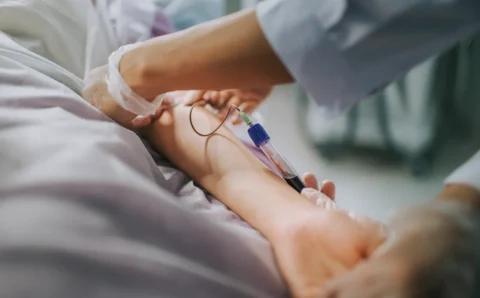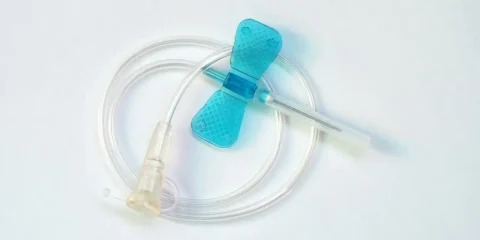One of the most commonly performed medical procedures among adult patients is venipuncture or blood collection. Experienced healthcare workers are trained in different blood draw techniques and one of those is the butterfly needle procedure. While it’s easy to use for simple blood specimen extractions, it can be quite tricky to remove butterfly needles from the vein and may lead to potential needlestick and sharps injuries if you’re not careful.
So what’s the proper retraction method for a butterfly needle? There are two types of butterfly needles for blood collection: standard and automatic retracting needles. When a standard winged infusion set is used, you need to retract the needle device by hand. Meanwhile, some butterfly needles have a push-button that will activate the spring retraction mechanism to automatically pull back the needle into the safety sleeve.
How to Retract a Butterfly Needle From The Vein After Blood Collection
Butterfly needles are medical instruments that are widely used to create venous access for blood collection, IV hydration, or intravenous delivery of medications. They’re also sometimes called ‘winged infusion’ or ‘scalp vein’ sets.
Compared to the typical needle and syringe barrel or evacuated tube systems, this blood collection set has unique characteristics and features. It’s made up of a thin, hypodermic needle that’s attached to a sheath with flexible wings and is connected to transparent tubing. This tubing may also have a needle hub or Luer lock which helps secure the needle in its position to avoid accidental removal or spilling of the contents.
It also has a safety feature that helps healthcare practitioners and phlebotomists safely withdraw the needle once the blood collection is completed. This is an essential component of any needle device and providers should always check if their blood collection set is equipped with it. With butterfly needles, there are two kinds of retraction mechanisms depending on their type.
- Standard Butterfly Needles with a Manual Retraction Mechanism: This type usually features a 21- or 23-gauge needle with a tube. When this is used for a blood draw, users have to manually pull back the needle by hand after the procedure.
- Winged Infusion Sets with a Push-Button Safety Device: These butterfly needles come with advanced retractable technology for safe needle removal after blood collection. It typically has a Luer lock and a push-button feature that can automatically withdraw the needle after a medical procedure.
Overview Of Steps On Proper Removal Of Butterfly Needle
Choosing which type of butterfly needle to use will depend on the skill and personal preference of the user. However, it’s important to familiarize yourself with the basic practices on the safe retraction of butterfly needles. Here’s what you need to know about the proper removal of butterfly needles after blood collection:
1. Remove the tourniquet from the patient’s arm
If you used a tourniquet prior to the insertion of the butterfly needle, you need to untie it first before you activate the safety feature. Forgetting to remove the tourniquet in place may lead to increased pressure in blood flow and cause blood to leak down the arm which will alarm the patient.
2. Prepare your gauze and withdraw the butterfly needle
As you get ready to retract the needle, make sure to have all your dressing equipment, such as gauze, tape, and bandage, beside you so you can easily reach them. Press the gauze lightly on the insertion area and retract the needle by its safety feature.
- If you’re using a butterfly needle with a standard safety device, you should hold its barrel and use one hand to pull the retractable needle by the cord.
- If you have the butterfly needle with a push-button feature, you simply have to click the button which will withdraw the needle into the barrel. Once it’s fully retracted, you can dispose of the used winged infusion set into the sharps container.
3. Use the gauze to stop bleeding and cover the area
As soon as you’ve withdrawn the needle, apply the gauze pad on the treated site and maintain light pressure to control the bleeding. Once the bleeding stops, you can tape the clean gauze on the skin to cover it.
You may also use an adhesive bandage to protect the treated area and maintain sterilization to begin the blood clotting process. Advise the patient to keep the bandage or gauze dressing on for at least 15 minutes or 24 hours, and they shouldn’t perform any strenuous activities or heavy lifting with their arm.
When to Engage Safety Lock Butterfly Needle
The safety feature of the butterfly needle must always be activated once the medical procedure is done. The retractable needle or safety lock must be engaged when you’ve collected the required amount of specimen.
If you’re gathering a specimen for a blood culture test, you’ll normally use the butterfly needle with an ETS tube holder. In these cases, you should first remove the blood collection tube prior to activating the safety feature. You should also be careful not to press down on the skin while the needle is still inside the vein as this can make the retraction painful for the patient.
When you use the butterfly needle for intravenous therapy, it’s usually attached to a catheter and tubing. Once the delivery of medications is complete, you should place a gauze pad over the insertion site before removing the catheter and performing the butterfly needle retraction. Remember to activate the safety feature to properly retrieve the needle before disposal.
Why You Should Always Activate the Safety Device Feature in Butterfly Needle Sets
Needlestick injuries and accidents are common occupational hazards in healthcare settings. According to the Centers for Disease Control and Prevention, there are approximately 385,000 injuries that occur annually among healthcare workers in hospitals and other practices.
The high risk for a needle stick injury with winged infusion sets is usually associated with the failure to activate its safety mechanism. Among the total reported cases of percutaneous exposure incidents in 2019, at least 2% of needlestick injuries are caused by butterfly needles. Other medical devices that are involved in these injuries are disposable syringe, suture needle, IV needle, and scalpel blade.
Knowing how to properly retract and engage the safety mechanism of butterfly needles will help reduce the incidence of needlestick and sharps injuries. It can also help prevent the transmission of blood-borne diseases and avoid the spread of infections from needles. Some of the common diseases that may be caused by a needle stick injury are hepatitis B and C, human immunodeficiency virus (HIV), herpes, malaria, and syphilis.
It’s important to always familiarize yourself with the safety feature of the butterfly needle before administration of medical procedures. You should also make sure to dispose of them in the sharps container to avoid unintentional needle reuse.
About Butterfly Needles: When is the Best Time to Use Them?
When performing blood collection, you need to carefully examine the patient and locate their visible veins. If they have superficial or smaller veins, a butterfly needle may be the best device to use. Its size is usually smaller than an IV catheter and can be used to collect venous blood in narrow and hard-to-reach veins.
Some of the patients who may be ideal candidates for a venipuncture procedure with butterfly needles are:
- Older adults or elderly patients with thin, rolling veins
- Infants and young children
- Patients with tiny veins on the hands, feet, or scalp
- Patients who are scared of large needles
In addition to blood collection, a butterfly needle can also be used to establish an IV line to deliver fluids to treat patients with dehydration or administer nutrient therapy to those who are temporarily unable to eat or drink properly. Doctors and nurses can also use butterfly needles to give medications via an intravenous method. This is helpful among individuals who can’t properly absorb medications and need immediate therapeutic relief.
Pros Of Using Butterfly Needles
While butterfly needles require more precision and skill, especially during retraction, they still offer plenty of advantages for extraction and infusion treatments. Here are some of the known benefits of the winged infusion set:
- Butterfly needles have flexible tubing which allows for better-angled insertion.
- Its transparent tubing also lets you visually monitor the blood flow during collection.
- Due to their thin size, butterfly needles are also less likely to cause profuse bleeding during IV infusion or blood collection.
- The wings that are placed on the sides of the needle help stabilize the needle once it’s placed in the blood vessel, reducing the risk of accidents that may lead to nerve damage, needle stick injury, or blown veins.
- There are also plenty of gauges to choose from depending on the type of procedure that will be performed.
Other Safety Guidelines on Administering Blood Draw and IV Infusion With Butterfly Needles
You can also assure safe venipuncture or infusion procedures by following the best practices for using butterfly needles. Here are other important guidelines that you need to remember when working with a winged infusion set:
- Always wash your hands and wear gloves prior to butterfly needle assembly and preparation.
- Make sure that you’re using sterilized needles, blood collection tubes, and needle holder.
- Disinfect the insertion site with 70% isopropyl alcohol to minimize the risk of infections.
- Once the procedure is done, retract the butterfly needle and throw them in the appropriate sharps container.
- Avoid reusing butterfly needles, syringes, and tubes to avoid percutaneous exposure injuries.
- Clean and sterilize the procedure room after every use and make sure there’s no visible sign of blood contamination on the work tables, chairs, and counters.
Get High-Quality Needles, Syringes, and Other Medical Tools at FACE Med Store
One of the important features that you need to look for in a butterfly needle device is its safety mechanism. This allows for quick and convenient retraction so your patient comes out from the blood collection without any discomfort and worry of risks of infections.
At FACE Med Store, we offer different gauges of butterfly needles for your blood extraction and infusion needs. We also provide high-quality syringes, tubes, and other medical tools and supplies at competitive prices. Call us today to know more about our stocks or browse our website to check related products.
